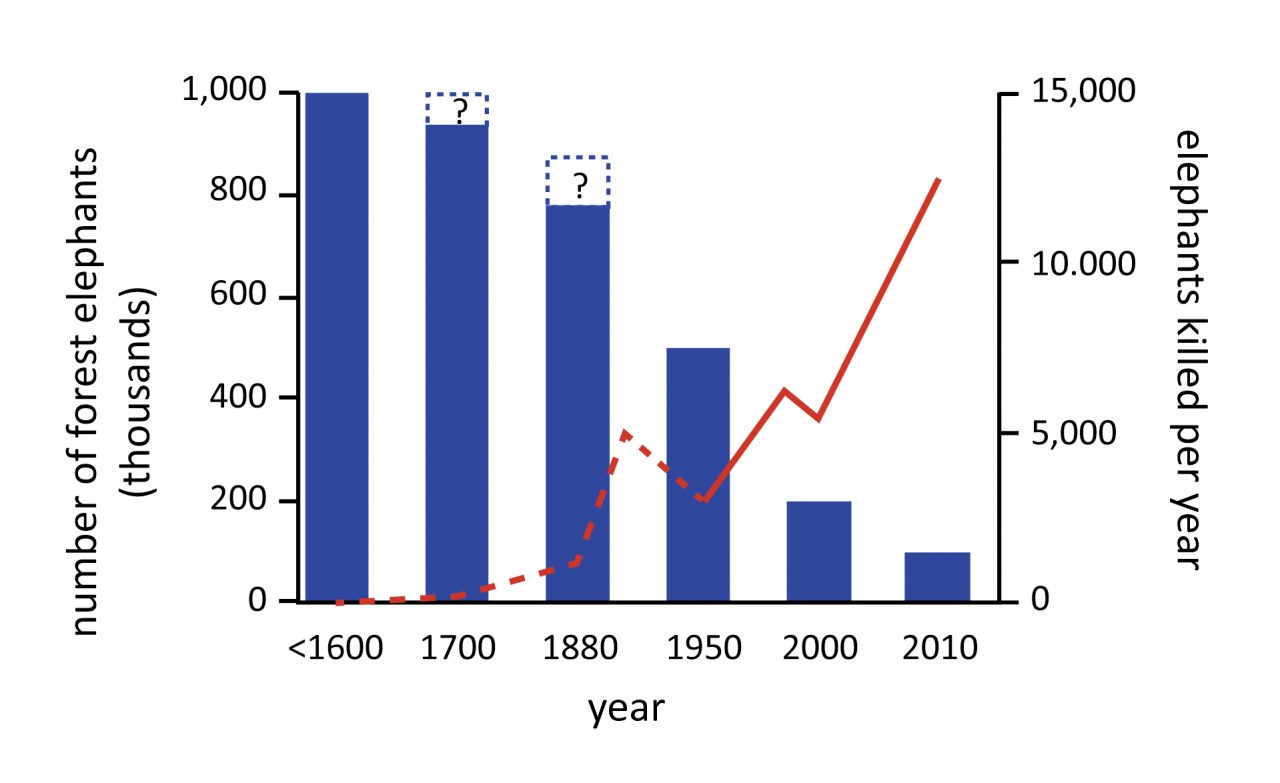A Species in Decline
African elephants are in rapid decline

Continental Poaching Crisis
The two species of African elephant (forest, Loxodonta cyclotis, and savanna, L. africana) are in severe trouble from poaching. This has become abundantly clear over the last decade with new analyses and research initiatives that focus on the state of elephant populations in Africa and on the strain that poaching exerts on these animals.
The current state of affairs is clearly unsustainable. As annual killings markedly exceed the growth rate of the species, most populations face the threat of extinction within several years (1). The most up-to-date estimates put the number of African elephants of both species killed illegally at 40,000 individuals per year. This level of loss, set against an estimated total of 500,000 elephants on the continent (400,000 savannah and only 100,000 forest), clearly shows the magnitude of threat posed by poaching. To put the current numbers in context, half a million elephants alive today represents a precipitous decline from the estimated one million elephants roaming the continent only 30 years ago, and the 10 million elephants thought to have lived at the beginning of the twentieth century. Another aspect of poaching that these studies reveal is the effect the decline of elephant populations has on surrounding ecosystems. Elephants are a keystone species, and the stability of their populations is a key component of the stability of the encircling ecological community as a whole. Thus the extermination of elephants destabilizes whole ecosystems, harming directly or indirectly, other species in the ecological community.
What has remained relatively unchanged all these years is the demand for ivory and the ferocity of poachers. As the price of ivory remains high on the black market, the flow of poachers ready to take the risk of illegal hunting for the promise of encouraging returns is as strong as ever. Even though the price of ivory has gone through periods of increases and decrease, poaching has persisted as a lucrative enterprise in the midst of unpromising economic performance in Central African nations. With the price now around $1,500 per pound, poaching for ivory creates one of the most profitable illegal markets in the world. Pieces of jewelry made of genuine ivory can cost upwards of $200,000.
Examples of wanton slaughter are easy to find. Bouba Ndjidah National Park in Cameroon, a scene of many incidents in the past, most notably the site that witnessed a six week period of intermittent slaughter that resulted in a death toll of 500 in early 2012, was shaken again in 2013, as poachers, armed with AK-47s and grenades, undertook another mass annihilation of elephants, leaving behind carcasses of 86 elephants. Also in 2013, the collapse of the government in the Central African Republic precipitated the one-day slaughter of 26 elephants in Dzanga Bai, the most important refuge for forest elephants in all of Africa. Current rates of poaching are unprecedented.
Another recent incident that has been particularly illuminating was the ruthless slaying of Satao, a “great tusker” in Kenya, which had been recognized as the largest living elephant on the planet. The story of Satao, killed by a poisoned arrow, as well as other instances of charismatic individuals slaughtered around the continent, sheds light on the fact that killing elephants is often more than just illegal activity for monetary gain. Superstitious beliefs that assign added mythical value to the hunting of elephants contribute to the incentives to kill. Still another set of superstitions, popular in the Far East, assign healing power to ivory, which, together with the prestige of the material itself, keeps the demand high.
As experts study the recent trends in poaching and completed surveys from the “Great Elephant Census”, the outlook is grim. Although the methodologies used to estimate the numbers of African elephants are diverse and the exact numbers often disagree, there is a universal agreement that African elephants, and forest elephants in particular, are under tremendous pressure from poaching. The skyrocketing demand for ivory from Asian markets and the resulting rates of poaching are clearly exceeding the natural rates of reproduction of the species. Current conservation efforts, carried out by individual nations as well as by groups of international wildlife conservation organizations, will now have to use this new information to inform their conservation initiatives. Continually evolving technology to study wildlife and methods of analysis that are now available to policymakers, conservationists and the general public make it possible to re-assess the threats of poaching, kindling hopes of increased awareness of the issue around the globe.
Continental Poaching Crisis
With the geographic range of elephants decreasing more and more, elephants are increasingly coming into conflict with people. Surveys indicate some locals see elephants as dangerous and a problem instead of as a remarkable and important species. Small farmers are forced by poor economic conditions to encroach on elephant habitat, increasing the risk of crop raids. Crop raids can deprive people of their livelihoods and deprive them or their own food. Locals do not always have the knowledge or the materials needed to properly deter and drive away elephants. Elephants are killed in some situations due to this. There are efforts to improve the habitat ranges for elephants, improve elephant detection, and develop deterrents to keep elephants out of fields. Education is also an important component in improving human-elephant conditions.

